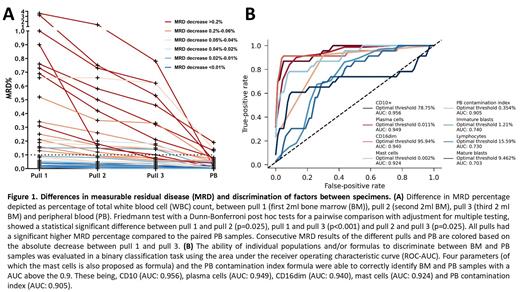Background: Measurable residual disease (MRD) detection plays a crucial role in assessing remission status and prognosis for acute myeloid leukemia (AML) patients. Multiparameter flow cytometry (MFC) and NPM1 gene mutations reverse transcriptase polymerase chain reaction (RT-PCR) are validated and recommended used methods for MRD measurement after two cycles of high-dose induction chemotherapy. However, the accuracy of MRD assessment can be compromised by hemodilution, a phenomenon that occurs during bone marrow (BM) aspiration when peripheral blood (PB) mixes with the BM sample. Due to the lower presence of MRD in PB, this may lead to false-negative results. Although formulas to quantify hemodilution exist, their validation and adoption remain limited, and the exact impact of hemodilution remains unclear.
Aim: This prospective study aimed to investigate the impact of hemodilution on MFC-MRD assessment by aspirating three sequential pulls of 2 ml each, instead of the standard 6 ml BM sample, and comparing them with a PB sample collected on the same day. Additionally, we evaluated the performance of different hemodilution formulas and analyzed changes in ratios/percentages of cell populations across the BM pulls and PB samples.
Methods: We included 30 AML patients in complete remission, resulting in 40 samples measured after one or two cycles of induction chemotherapy with 46 leukemia-associated immunophenotypes (LAIPs). The first 2 ml of BM were collected as the “first pull”, followed by a second aspirate of another 2 ml to form the “second pull”. This process was repeated to obtain the “third pull”. Precautions were taken during BM aspiration to prevent aspirate loss between pulls, and the aspiration needle remained stationary throughout the procedure. All samples from one time point were analyzed on the same machine by the same operator. The formulas proposed for hemodilution assessment were evaluated using a newly developed tube containing additional markers (CD10, CD16, CD38, and CD138) not present in the standard MFC-MRD assay. Differences in outcomes from the formulas and cell populations across the specimens were analyzed using the non-parametric Friedman's ANOVA test. Moreover, the ability of individual populations or formulas to differentiate between BM and PB samples was assessed using the area under the receiver operating characteristic curve (ROC-AUC) in a binary classification task.
Results: Significant decreases in blasts and median MRD% were observed between different pulls and PB samples. The median MRD% in pull 1 (0.06%) was significantly higher than in pull 2 (0.05%), pull 3 (0.04%), and PB (0.01%) ( P<0.001). Pairwise comparisons, adjusted for multiple testing, revealed significant differences between pull 1 and pull 2 ( P=0.025), and between pull 2 to pull 3 ( P=0.025), indicating the effect of hemodilution ( Figure 1A). In the first pull 18/46 LAIPs were above the 0.1% cut-off, compared to 14/46 in the third pull. This resulted in 9 patients being MRD-positive in the first/second pull, compared to 8 patients in the third pull. The evaluated formulas demonstrated progressively higher quantities of diluted samples from pull 1 to PB. Five parameters exhibited an AUC above 0.9, indicating their ability to differentiate between BM and PB samples. These parameters are CD10 (AUC: 0.956), plasma cells (AUC: 0.949), CD16 dim cells (AUC: 0.940), mast cells (AUC: 0.924), and the PB contamination index formula (AUC: 0.905) ( Figure 1B).
Conclusion: Hemodilution occurs even after aspirating the initial milliliters of BM, emphasizing the need to consider hemodilution when assessing MRD in AML to avoid false-negative results. We recommend incorporating a hemodilution detection formula into routine practice for AML patients to further evaluate the effect on clinical choices. The results of this study support the examination of the CD16 dim population or mast cell population (CD117hi) for this purpose. Furthermore, we suggest implementing a practical approach that involves numbering each pull of BM during aspiration and taking this into account when giving the final MRD result, thus providing clarity regarding the specific pull being measured. In cases of doubt (e.g., MFC-MRD between 0.07% and 0.09% in a later pull), repeating the BM aspiration is recommended to ensure reliability.
Disclosures
Ossenkoppele:Novartis: Consultancy, Honoraria, Research Funding; Pfizer: Consultancy; BMS/Celgene: Consultancy, Honoraria; Janssen: Consultancy; AGIOS: Consultancy, Honoraria; Amgen: Consultancy; Gilead: Consultancy, Honoraria; Astellas: Consultancy, Honoraria; Roche: Consultancy, Membership on an entity's Board of Directors or advisory committees; Jazz Pharmaceuticals: Consultancy; Merus: Consultancy. de Leeuw:Servier: Consultancy, Other: Advisory role; Roche: Consultancy, Other: Advisory role; Abbvie: Other: Travel, accomodation expenses; Abbvie: Consultancy, Other: Advisory role ; Takeda: Consultancy, Other: Advisory role. Janssen:Daiichi-Sankyo: Other: Apps for Care and Science and non-profit foundation support ; Janssen: Other: Apps for Care and Science and non-profit foundation support ; Olympus: Other: Apps for Care and Science and non-profit foundation support ; Incyte: Honoraria, Membership on an entity's Board of Directors or advisory committees, Other: Apps for Care and Science and non-profit foundation support ; Sanofi Gemzyme: Other: Apps for Care and Science and non-profit foundation support ; Servier: Other: Apps for Care and Science and non-profit foundation support ; Jazz: Other: Apps for Care and Science and non-profit foundation support ; Takeda: Other: Apps for Care and Science and non-profit foundation support ; Abbvie: Honoraria, Membership on an entity's Board of Directors or advisory committees; Pfizer: Honoraria, Membership on an entity's Board of Directors or advisory committees; Astellas: Other: Apps for Care and Science and non-profit foundation support ; Amgen: Other: Apps for Care and Science and non-profit foundation support ; BMS: Other: Apps for Care and Science and non-profit foundation support , Research Funding; Novartis: Honoraria, Membership on an entity's Board of Directors or advisory committees, Research Funding. Cloos:Takeda: Research Funding; Navigate: Consultancy, Patents & Royalties: Royalties MRD assay; BD Biosciences: Patents & Royalties: Royalties LSC tube; Novartis: Consultancy, Research Funding.


This feature is available to Subscribers Only
Sign In or Create an Account Close Modal